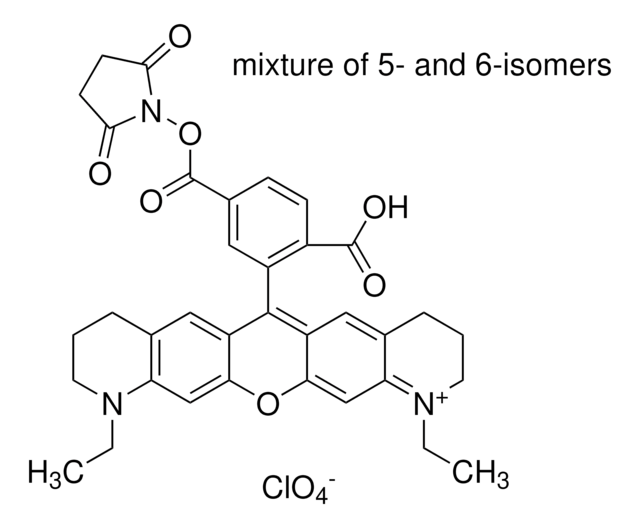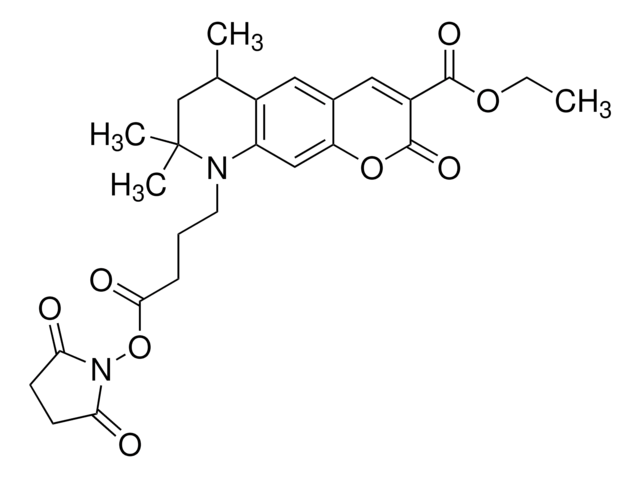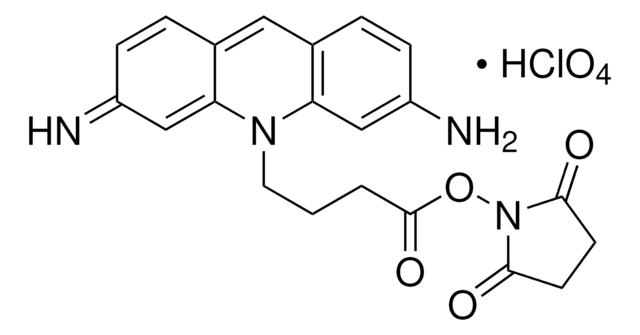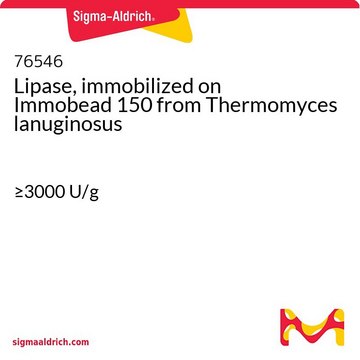88793
Atto 532 NHS ester
BioReagent, suitable for fluorescence, ≥90% (HPLC)
Synonym(s):
Atto 532
Sign Into View Organizational & Contract Pricing
All Photos(1)
About This Item
Recommended Products
product line
BioReagent
Quality Level
Assay
≥90% (HPLC)
≥90% (degree of coupling)
form
powder
manufacturer/tradename
ATTO-TEC GmbH
λ
in methanol: water (1:1) (with 0.1% perchloric acid)
UV absorption
λ: 532-538 nm Amax
suitability
suitable for fluorescence
storage temp.
−20°C
General description
Atto 532 NHS ester is a fluorescent dye related to the well-known laser dye, Rhodamine 6G. The fluorescence activity is excited efficiently at the 515-545nm range. A suitable excitation source for Atto 532 is the 532 nm output of the frequency-doubled Nd: YAG laser.
Application
Atto 532 NHS ester is highly suitable for single-molecule detection applications and high-resolution microscopy such as PALM, dSTORM, and STED. In addition, the dye is used in flow cytometry (FACS) and fluorescence in-situ hybridization (FISH) methods.
Features and Benefits
Characteristic features of the Atto 532 NHS ester are:
- Strong Absorption.
- High Fluorescence quantum yield.
- High Photostability.
- Excellent water solubility.
Not finding the right product?
Try our Product Selector Tool.
Storage Class Code
11 - Combustible Solids
WGK
WGK 3
Flash Point(F)
Not applicable
Flash Point(C)
Not applicable
Personal Protective Equipment
dust mask type N95 (US), Eyeshields, Gloves
Choose from one of the most recent versions:
Already Own This Product?
Find documentation for the products that you have recently purchased in the Document Library.
Customers Also Viewed
Rumelo Amor et al.
Scientific reports, 4, 7359-7359 (2014-12-09)
Standing-wave excitation of fluorescence is highly desirable in optical microscopy because it improves the axial resolution. We demonstrate here that multiplanar excitation of fluorescence by a standing wave can be produced in a single-spot laser scanning microscope by placing a
Roland Bienert et al.
Chemphyschem : a European journal of chemical physics and physical chemistry, 12(3), 510-517 (2011-02-03)
H(+)-ATP synthases are molecular machines which couple transmembrane proton transport with ATP synthesis from ADP and inorganic phosphate by a rotational mechanism. Single-pair fluorescence resonance energy transfer (spFRET) in single molecules is a powerful tool to analyse conformational changes. It
Wonchul Shin et al.
Cell, 173(4), 934-945 (2018-04-03)
Fusion is thought to open a pore to release vesicular cargoes vital for many biological processes, including exocytosis, intracellular trafficking, fertilization, and viral entry. However, fusion pores have not been observed and thus proved in live cells. Its regulatory mechanisms and
Evidence for major structural changes in subunit C of the vacuolar ATPase due to nucleotide binding.
Andrea Armbrüster et al.
FEBS letters, 579(9), 1961-1967 (2005-03-29)
The ability of subunit C of eukaryotic V-ATPases to bind ADP and ATP is demonstrated by photoaffinity labeling and fluorescence correlation spectroscopy (FCS). Quantitation of the photoaffinity and the FCS data indicate that the ATP-analogues bind more weakly to subunit
Daniel Aquino et al.
Nature methods, 8(4), 353-359 (2011-03-15)
We demonstrate three-dimensional (3D) super-resolution imaging of stochastically switched fluorophores distributed across whole cells. By evaluating the higher moments of the diffraction spot provided by a 4Pi detection scheme, single markers can be simultaneously localized with <10 nm precision in
Articles
Fluorescent Labeling of Peptides
Our team of scientists has experience in all areas of research including Life Science, Material Science, Chemical Synthesis, Chromatography, Analytical and many others.
Contact Technical Service







